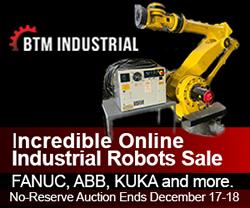Meet Marty, Your New Robotic Retail Worker
Talking ProMat 2019 with Schmalz
Talking Automate 2019 with Dorner Conveyors
Swift Navigation Case Study: Left Hand Robotics
ATI's Connections Help Map the Galaxy with "WEAVE"
50,000 Warehouses to Use Robots by 2025 as Barriers to Entry Fall and AI Innovation Accelerates
Talking Automate 2019 with TÃœV Rheinland
Talking Automate 2019 with PIAB
Talking Automate 2019 with ATI Industrial Automation
Researchers create new kind of robot composed of many simple particles with no centralized control or single point of failure
Automate Q&A with MiR
Automate Q&A with Elmo Motion Control
20,000 Autonomous Mobile Robots (AMRs) Shipped in 2018
Automate Q&A with IPR Robotics
Automate Q&A with Octopuz
Records 1681 to 1695 of 3729
First | Previous | Next | Last
Featured Product

BTM Industrial -The industry leader in assisting companies with surplus assets.
Robotics and Automation - Featured Company

